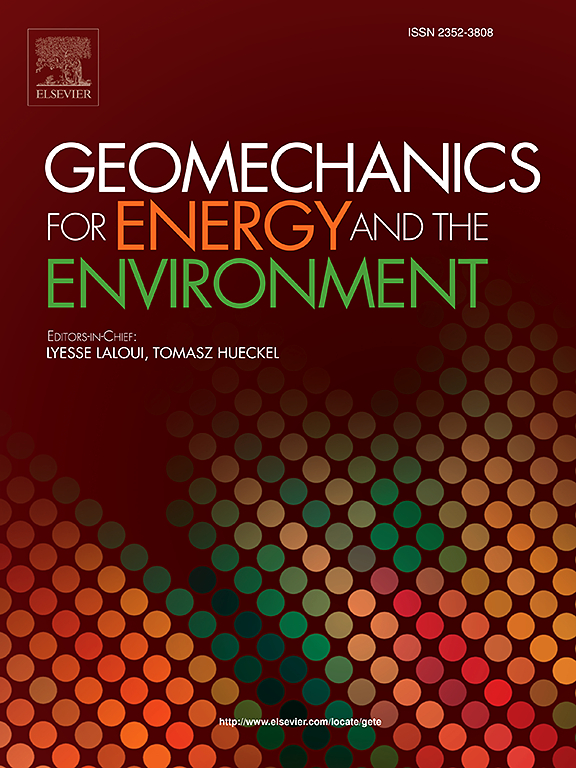不同等级水饱和煤在液氮冻融作用下的损伤及声学特性
IF 3.7
2区 工程技术
Q3 ENERGY & FUELS
引用次数: 0
摘要
地质变异性导致不同等级的煤层具有不同的物理性质,严重影响液氮(LN 2)压裂效果。通过超声测量、单轴压缩和声发射(AE)技术,系统地评估了褐煤、烟煤和无烟煤三种代表性煤种的单次LN2冻融(LNSFT)和多次冻融循环(LNCFT)引起的力学和声学损伤。结果表明:孔隙水凝固初期增强了煤的强度和声完整性;随后,由冻胀、热应力和LN 2膨胀引起的裂纹萌生和扩展逐渐削弱了这些特性。这种强化与弱化之间的平衡主要是由煤的孔隙结构、裂隙和含水率决定的。加载作用下的声发射模式明显遵循稳态、激活和衰减阶段,冻结和融化阶段都促进了剪切导向裂缝的发育。由超声纵波速度(v)、峰值强度(σ)和弹性模量(E)计算的损伤指数(D)表明,冻融损伤程度与煤阶呈负相关,表明煤阶越高,结构稳定性和抗冻融能力越强。此外,在相同的累积冻结时间下,LNCFT造成的损伤明显大于LNSFT,突出了累积损伤效应。这些见解为优化旨在提高煤层渗透率的LN 2压裂技术提供了重要指导。本文章由计算机程序翻译,如有差异,请以英文原文为准。
Damage and acoustic characteristics of water-saturated coals with different ranks under liquid nitrogen freezing and thawing treatments
Geological variability results in coal seams with diverse ranks exhibiting distinct physical properties, critically influencing liquid nitrogen (LN₂) fracturing outcomes. We systematically assess the mechanical and acoustic damage induced by single LN2 freeze-thaw (LNSFT) and repeated freeze-thaw cycles (LNCFT) in three representative coal ranks—lignite, bituminite, and anthracite—via ultrasonic measurement, uniaxial compression, and acoustic emission (AE) techniques. Results demonstrate that initially, pore water solidification enhances coal strength and acoustic integrity; subsequently, crack initiation and propagation induced by frost heave, thermal stress, and LN₂ expansion progressively weaken these properties. This balance between strengthening and weakening is primarily governed by coal pore structure, fissures, and moisture content. AE patterns under loading distinctly follow steady-state, activation, and attenuation phases, with both the freezing and thawing phases promoting shear-oriented fracture development. Damage indices (D), computed from ultrasonic P-wave velocity (v), peak strength (σ), and elastic modulus (E), reveal an inverse correlation between freeze-thaw damage severity and coal rank, indicating that higher-rank coals exhibit greater structural stability and freeze-thaw resistance. Furthermore, under equivalent cumulative freezing durations, LNCFT cause significantly greater damage than LNSFT, highlighting a cumulative damage effect. These insights provide critical guidance for optimizing LN₂ fracturing techniques aimed at enhancing coal seam permeability.
求助全文
通过发布文献求助,成功后即可免费获取论文全文。
去求助
来源期刊

Geomechanics for Energy and the Environment
Earth and Planetary Sciences-Geotechnical Engineering and Engineering Geology
CiteScore
5.90
自引率
11.80%
发文量
87
期刊介绍:
The aim of the Journal is to publish research results of the highest quality and of lasting importance on the subject of geomechanics, with the focus on applications to geological energy production and storage, and the interaction of soils and rocks with the natural and engineered environment. Special attention is given to concepts and developments of new energy geotechnologies that comprise intrinsic mechanisms protecting the environment against a potential engineering induced damage, hence warranting sustainable usage of energy resources.
The scope of the journal is broad, including fundamental concepts in geomechanics and mechanics of porous media, the experiments and analysis of novel phenomena and applications. Of special interest are issues resulting from coupling of particular physics, chemistry and biology of external forcings, as well as of pore fluid/gas and minerals to the solid mechanics of the medium skeleton and pore fluid mechanics. The multi-scale and inter-scale interactions between the phenomena and the behavior representations are also of particular interest. Contributions to general theoretical approach to these issues, but of potential reference to geomechanics in its context of energy and the environment are also most welcome.
 求助内容:
求助内容: 应助结果提醒方式:
应助结果提醒方式:


